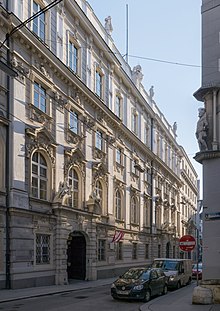Palais Rottal

The Palais Rottal is a palace in the 1st district of Vienna. It is located at the Singerstraße / Grünangergasse intersection. Today the palace houses the Ombudsman's Office and the Financial Procuratorate .
The original buildings
The original Palais Rottal
The original Palais Rottal was probably built between 1667 and 1683 by converting the previous building. Although the name of the architect is not known, the building is attributed to Giovanni Pietro Tencalla , who worked as an architect for the Rottal family during this period .
Only the two portals and the vestibule have survived from this building .
The Billiotte Foundation House
Franz Billiotte was born in France and was the personal physician of Emperor Leopold I. He was appointed to Vienna in 1665 on behalf of the Lower Austrian estates to set up a botanical garden for scientific purposes. Billiotte was very committed to the poor and also donated the building mentioned above. In this house, the poor received board and lodging, and Billiotte also held ordinations there free of charge. After Billiotte's death, the building became a foundation that was supposed to guarantee the continued existence of the building for the poor.
The house was probably redesigned / renovated by the Vorarlberg architect Anton Ospel before 1733 . It was a simple four-story building with a lavishly designed portal.
In 1741 the foundation fell to the Dreifaltigkeitsspital and in 1745 together with the latter to the unified Spanish hospital . Around this time, both the foundation house and the Palais Rottal became the property of the Wiener Stadtbank (Wiener Stadt-Banco).
Reconstruction and consolidation of the buildings
After the acquisition by the Stadtbank, the original palace was extensively renovated in 1752. The architect in charge was Franz Anton Pilgram , a student of Johann Lucas von Hildebrandt . The palace was raised by one floor and a large central courtyard was created. The grand staircase is a masterpiece of Viennese baroque architecture, the very long staircase made of hard imperial stone was delivered from Kaisersteinbruch by the masters Elias Hügel and Johann Baptist Regondi .
The facade was also opulently redesigned and is largely preserved in this form today.
A few years after the reconstruction of the palace, it was combined with the foundation house to form a single building. For this purpose, among other things, the facade of the foundation house was adapted to that of the palace, and a building to the north of the foundation house was integrated into the building complex.
Further structural changes
Starting in 1842, the building was increased by one floor during renewed renovations. In addition, an attic was attached to the new floor . Figures that were previously used in Prince Eugene's Winter Palace in Himmelpfortgasse were attached to this .
From 1849 the palace housed the newly founded Imperial and Royal Ministry for Cultus and Education 1, led by Leo von Thun-Hohenstein , before serving as the seat of the financial administration in later decades of the 19th century.
The last major renovation took place in 1903/1904. For this purpose, two houses in Kumpfgasse were demolished in order to enable the extension of the rear wing to the palace. In addition to the financial administration, the building also served as an official building for parties related to it, such as the state debt collection office, until the end of the Second World War.
After the Second World War, the Central Pay Office used the building.
After several years of renovation, part of the building has been used by the financial procuratorate since March 1981 and the remaining part since 1983 by the ombudsman's office.
Web links
- Building history of the Palais Rottal (PDF; 213 kB)
- Entry via Palais Rottal to Burgen-Austria
Coordinates: 48 ° 12 ′ 25 ″ N , 16 ° 22 ′ 30 ″ E


